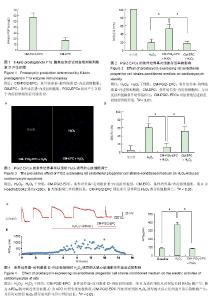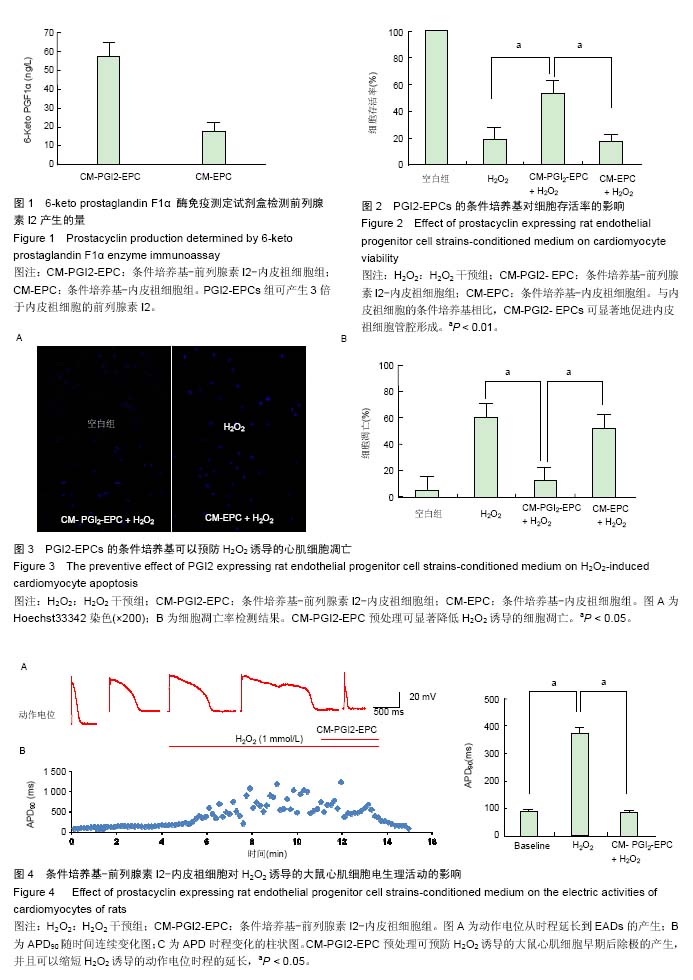Chinese Journal of Tissue Engineering Research ›› 2016, Vol. 20 ›› Issue (20): 2949-2956.doi: 10.3969/j.issn.2095-4344.2016.20.009
Previous Articles Next Articles
Cardiac protection of prostacyclin secreted from endothelial progenitor cells against oxidative stress-induced apoptosis: verified by cardiac electrophysiological tests
Zhang Jing, Ruan Lu, Kang Li, Cui Xiao-hai, Zhang Jia
- Second Department of Thoracic Surgery, First Affiliated Hospital of Xi’an Jiaotong University, Xi’an 710061, Shaanxi Province, China
-
Received:2016-03-04Online:2016-05-13Published:2016-05-13 -
Contact:Zhang Jia, M.D., Attending physician, Second Department of Thoracic Surgery, First Affiliated Hospital of Xi’an Jiaotong University, Xi’an 710061, Shaanxi Province, China -
About author:Zhang Jing, Master, Attending physician, Second Department of Thoracic Surgery, First Affiliated Hospital of Xi’an Jiaotong University, Xi’an 710061, Shaanxi Province, China -
Supported by:the Scientific and Technological Planning Project of Shaanxi Province, No. 2014KW23-02; the Fundamental Research Funds for the Central Universities
CLC Number:
Cite this article
Zhang Jing, Ruan Lu, Kang Li, Cui Xiao-hai, Zhang Jia. Cardiac protection of prostacyclin secreted from endothelial progenitor cells against oxidative stress-induced apoptosis: verified by cardiac electrophysiological tests[J]. Chinese Journal of Tissue Engineering Research, 2016, 20(20): 2949-2956.
share this article
| [1] World Health Organization.Global atlas on cardiovascular disease prevention and control, World Health Organization: WHO; World Heart Federation; World Stroke Organization. Geneva: WHO; 2011.[2] Libby P. Mechanisms of acute coronary syndromes and their implications for therapy. The New England journal of medicine. 2013; 368(21):2004-13. [3] Tricoci P, Huang Z, Held C, et al. Thrombin-receptor antagonist vorapaxar in acute coronary syndromes. The New England journal of medicine. 2012; 366(1): 20-33.[4] Penn MS, Mangi AA. Genetic enhancement of stem cell engraftment,survival, and efficacy. Circ Res. 2008;2:1471-1482.[5] Merx MW, Zernecke A, Liehn EA,et al. Transplantation of human umbilical vein endothelial cells improves left ventricular function in a rat model of myocardial infarction. Basic Res Cardiol 2005;100: 208-216.[6] Schuh A, Liehn EA, Sasse A, et al.Improved left ventricular function after transplantation of microspheres and fibroblasts in a rat model of myocardial infarction. Basic Res Cardiol.2009; 104: 403-411.[7] Dubois C, Liu X, Claus P, et al.Differential effects of progenitor cell populations on left ventricular remodeling and myocardial neovascularization after myocardial infarction. J Am Coll Cardiol.2010; 55: 2232-2243.[8] Werner N, Kosiol S, Schiegl T, et al.Circulating endothelial progenitor cells and cardiovascular outcomes. N Engl J Med.2005;353:999-1007.[9] [Yao EH, Fukuda N, Matsumoto T, et al.Effects of the antioxidative beta-blocker celiprolol on endothelial progenitor cells in hypertensive rats. Am J Hypertens. 2008;21:1062-1068.[10] Hill JM, Zalos G, Halcox JP, et al.Circulating endothelial progenitor cells, vascular function, and cardiovascular risk. N Engl J Med.2003; 348: 593-600.[11] Fadini GP, Miorin M, Facco M,et al.Circulating endothelial progenitor cells are reduced in peripheral vascular complications of type 2 diabetes mellitus. J Am Coll Cardiol.2005;45:1449-1457.[12] Ghani U, Shuaib A, Salam A,et al.Endothelial progenitor cells during cerebrovascular disease. Stroke.2005;36:151-153.[13] Schmidt-Lucke C, Rossig L, Fichtlscherer S, et al. Reduced number of circulating endothelial progenitor cells predicts future cardiovascular events: proof of concept for the clinical importance of endogenous vascular repair. Circulation.2005;111:2981-2987.[14] Chang ZT, Hong L, Wang H,et al. Application of peripheral-blood-derived endothelial progenitor cell for treating ischemia-reperfusion injury and infarction: a preclinical study in rat models. J Cardiothorac Surg. 2013,8:33.[15] Cheng K, Wei MQ, Jia GL,et al. Effects of metoprolol and small intestine RNA on marrow-derived endothelial progenitor cells applied for autograft transplantation in heart disease. Eur Rev Med Pharmacol Sci. 2014;18(11):1666-73.[16] Bunting S, Gryglewski R, Moncada S,et al. Arterial walls generate from prostaglandin endoperoxides a substance (prostaglandin X) which relaxes strips of mesenteric and coeliac ateries and inhibits platelet aggregation.Prostaglandins.1976;12:897-913.[17] Morita I.Distinct functions of COX-1 and COX-2. Prostaglandins Other LipidMediat 2002;68-69: 165-175.[18] Hinz B, Brune K.Cyclooxygenase-2–10 years later. J Pharmacol Exp Ther.2002;300:367-375.[19] Smith 3rd EF, Gallenkamper W, Beckmann R, et al.Early and late administration of a PGI2-analogue, ZK 36 374 (iloprost): effects on myocardial preservation, collateral blood flow and infarct size. Cardiovasc Res.1984;18:163-173.[20] Schror K, Woditsch I.Endogenous prostacyclin preserves myocardial function and endothelium-derived nitric oxide formation in myocardial ischemia.Agents Actions Suppl 1992;37:312-319.[21] Woditsch I, Schror K. Prostacyclin rather than endogenous nitric oxide is a tissue protective factor in myocardial ischemia. Am J Physiol.1992;263: H1390-1396.[22] Szekeres L, Koltai M, Pataricza J,et al. On the late antiischaemic action of the stable PgI2 analogue: 7-oxo-PgI2-Na and its possible mode of action.Biomed Biochim Acta 1984;43:S135-142.[23] Darius H, Osborne JA, Reibel DK,et al. Protective actions of a stable prostacyclin analog in ischemia induced membrane damage in rat myocardium. J Mol Cell Cardiol.1987;19:243-50.[24] Penna C, Mancardi D, Tullio F, et al. Postconditioning and intermittent bradykinin induced cardioprotection require cyclooxygenase activation and prostacyclin release during reperfusion. Basic Res Cardiol 2008; 103:368-377.[25] Ueno Y, Shigenobu K, Nishio S. Effect of beraprost sodium on changes in action potentials during hypoxia as compared with propranolol, diltiazem and glibenclamide in guinea-pig ventricular muscle. Arch Int Pharmacodyn Ther 1994;328:191-199.[26] Tanaka H, Matsui S, Shigenobu K. Cardioprotective effects of beraprost sodium against experimental ischemia and reperfusion as compared with propranolol and diltiazem. Res Commun Mol Pathol Pharmacol 1998;99:321-327.[27] Shinmura K, Tamaki K, Sato T, et al. Prostacyclin attenuates oxidative damage of myocytes by opening mitochondrial ATP-sensitive K+ channels via the EP3 receptor. Am J Physiol Heart Circ Physiol 2005; 288 : H2093-2101.[28] Barst RJ, Rubin LJ, Long WA, et al. A comparison of continuous intravenous epoprostenol (prostacyclin) with conventional therapy for primary pulmonary hypertension. The Primary Pulmonary Hypertension Study Group. N Engl J Med. 1996;334(5):296-302.[29] Liu Q, Xi Y, Terry T, et al. Engineered endothelial progenitor cells that overexpress prostacyclin protect vascular cells. J Cell Physiol. 2012,227(7): 2907-2916.[30] Ibáñez B, Heusch G, Ovize M, et al. Evolving therapies for myocardial ischemia/reperfusion injury. J Am Coll Cardiol. 2015,65(14):1454-1471.[31] Gustafsson AB, Gottlieb RA. Mechanisms of apoptosis in the heart. J Clin Immunol. 2003;23(6): 447-59.[32] Rodrigo J, Fernández AP, Serrano J,et al. The role of free radicals in cerebral hypoxia and ischemia. Free Radic Biol Med. 2005;39(1):26-50.[33] Sharikabad MN,Østbye KM,Brørs O. Effect of hydrogen peroxide on reoxygenation-induced Ca2+ accumulation in rat cardiomyocytes. Free Radic Biol Med. 2004;37(4):531-538.[34] Zhou T, Chuang CC, Zuo L. Molecular Characterization of Reactive Oxygen Species in Myocardial Ischemia-Reperfusion Injury. Biomed Res Int. 2015;2015:864946.[35] Hur J, Yoon CH, Kim HS, et al.Characterization of two typesofendothelial progenitor cellsand theirdifferent contributions to neovasculogenesis. Arterioscler Thromb Vasc Biol 2004;(24): 288-293.[36] Zhou B, Xiao C.Prevention of diabetic microangiopathy by prophylactic transplant of mobilized peripheral blood mononuclear cells. Acta Pharmacologica Sinica.2006;28(1): 89-97.[37] Yang C, Zhang ZH, Li ZJ, et al. Enhancement of neovascularization with cord blood CD133+ cell-derived endothelial progenitor cell transplantation. Thromb Haemost.2004;91: 1202-1212.[38] Li S, Zhou B, Han ZC.Therapeutic neovascularization by transplantation of mobilized peripheral blood mononuclear cells for limb ischemia: a comparison between CD34+ and CD34_ mononuclear cells. Thromb Haemost 2006; 95: 301-311.[39] Zhou B, Feng XM. Impaired therapeutic vasculogenesis by transplantation of OxLDL-treated endothelial progenitor cells. J Lipid Res. 2007;48(3): 518-527[40] Yamaguchi J, Kusano KF,Masuo O, et al. Stromal cell-derived factor-1 effectson ex vivo expanded endothelial progen itorcell recruitment for ischemic neovascularization. Circulation 2003;107(9):1322.[41] Hamano K, Li TS, Kobayashi T, et al. The induction of angiogenesis by the implantation of autologous bone marrow cells: A novel and simple therapeutic method. Surgery 2001;130(1):44-54.[42] 杨亚荣,曾秋棠,郎明健,等.内皮祖细胞移植对大鼠心肌梗死后缺血心肌血管再生及心功能的影响[J].中国组织工程研究与临床康复,2008,12(25):4815-4818.[43] 张佳,赵志龙,张明鑫,等.Iloprost对DOX引起CPCs损伤的预防作用.西安交通大学学报:医学版,2013,34(4): 544-547.[44] Sun J, Zhang J, Yan W, et al.Iloprost prevents doxorubicin mediated human cardiac progenitor cell depletion. Int J Cardiol.2014;176(2):536-539. |
| [1] | Zhang Tongtong, Wang Zhonghua, Wen Jie, Song Yuxin, Liu Lin. Application of three-dimensional printing model in surgical resection and reconstruction of cervical tumor [J]. Chinese Journal of Tissue Engineering Research, 2021, 25(9): 1335-1339. |
| [2] | Zeng Yanhua, Hao Yanlei. In vitro culture and purification of Schwann cells: a systematic review [J]. Chinese Journal of Tissue Engineering Research, 2021, 25(7): 1135-1141. |
| [3] | Nie Huijuan, Huang Zhichun. The role of Hedgehog signaling pathway in transforming growth factor beta1-induced myofibroblast transdifferentiation [J]. Chinese Journal of Tissue Engineering Research, 2021, 25(5): 754-760. |
| [4] | Xu Dongzi, Zhang Ting, Ouyang Zhaolian. The global competitive situation of cardiac tissue engineering based on patent analysis [J]. Chinese Journal of Tissue Engineering Research, 2021, 25(5): 807-812. |
| [5] | Wu Zijian, Hu Zhaoduan, Xie Youqiong, Wang Feng, Li Jia, Li Bocun, Cai Guowei, Peng Rui. Three-dimensional printing technology and bone tissue engineering research: literature metrology and visual analysis of research hotspots [J]. Chinese Journal of Tissue Engineering Research, 2021, 25(4): 564-569. |
| [6] | Chang Wenliao, Zhao Jie, Sun Xiaoliang, Wang Kun, Wu Guofeng, Zhou Jian, Li Shuxiang, Sun Han. Material selection, theoretical design and biomimetic function of artificial periosteum [J]. Chinese Journal of Tissue Engineering Research, 2021, 25(4): 600-606. |
| [7] | Liu Fei, Cui Yutao, Liu He. Advantages and problems of local antibiotic delivery system in the treatment of osteomyelitis [J]. Chinese Journal of Tissue Engineering Research, 2021, 25(4): 614-620. |
| [8] | Li Xiaozhuang, Duan Hao, Wang Weizhou, Tang Zhihong, Wang Yanghao, He Fei. Application of bone tissue engineering materials in the treatment of bone defect diseases in vivo [J]. Chinese Journal of Tissue Engineering Research, 2021, 25(4): 626-631. |
| [9] | Zhang Zhenkun, Li Zhe, Li Ya, Wang Yingying, Wang Yaping, Zhou Xinkui, Ma Shanshan, Guan Fangxia. Application of alginate based hydrogels/dressings in wound healing: sustained, dynamic and sequential release [J]. Chinese Journal of Tissue Engineering Research, 2021, 25(4): 638-643. |
| [10] | Chen Jiana, Qiu Yanling, Nie Minhai, Liu Xuqian. Tissue engineering scaffolds in repairing oral and maxillofacial soft tissue defects [J]. Chinese Journal of Tissue Engineering Research, 2021, 25(4): 644-650. |
| [11] | Xing Hao, Zhang Yonghong, Wang Dong. Advantages and disadvantages of repairing large-segment bone defect [J]. Chinese Journal of Tissue Engineering Research, 2021, 25(3): 426-430. |
| [12] | Chen Siqi, Xian Debin, Xu Rongsheng, Qin Zhongjie, Zhang Lei, Xia Delin. Effects of bone marrow mesenchymal stem cells and human umbilical vein endothelial cells combined with hydroxyapatite-tricalcium phosphate scaffolds on early angiogenesis in skull defect repair in rats [J]. Chinese Journal of Tissue Engineering Research, 2021, 25(22): 3458-3465. |
| [13] | Wang Hao, Chen Mingxue, Li Junkang, Luo Xujiang, Peng Liqing, Li Huo, Huang Bo, Tian Guangzhao, Liu Shuyun, Sui Xiang, Huang Jingxiang, Guo Quanyi, Lu Xiaobo. Decellularized porcine skin matrix for tissue-engineered meniscus scaffold [J]. Chinese Journal of Tissue Engineering Research, 2021, 25(22): 3473-3478. |
| [14] | Mo Jianling, He Shaoru, Feng Bowen, Jian Minqiao, Zhang Xiaohui, Liu Caisheng, Liang Yijing, Liu Yumei, Chen Liang, Zhou Haiyu, Liu Yanhui. Forming prevascularized cell sheets and the expression of angiogenesis-related factors [J]. Chinese Journal of Tissue Engineering Research, 2021, 25(22): 3479-3486. |
| [15] | Liu Chang, Li Datong, Liu Yuan, Kong Lingbo, Guo Rui, Yang Lixue, Hao Dingjun, He Baorong. Poor efficacy after vertebral augmentation surgery of acute symptomatic thoracolumbar osteoporotic compression fracture: relationship with bone cement, bone mineral density, and adjacent fractures [J]. Chinese Journal of Tissue Engineering Research, 2021, 25(22): 3510-3516. |
| Viewed | ||||||
|
Full text |
|
|||||
|
Abstract |
|
|||||

